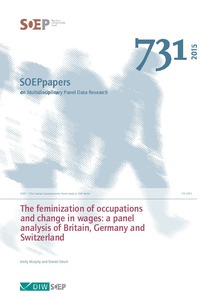The feminization of occupations and change in wages: a panel analysis of Britain, Germany and Switzerland
"In the last four decades, women have made major inroads into occupations previously dominated by men. This paper examines whether occupational feminization is accompanied by a decline in wages: Do workers suffer a wage penalty if they remain in, or move into, feminizing occupations? We analzye...
| Main Authors: | , |
|---|---|
| Institution: | ETUI-European Trade Union Institute |
| Format: | TEXT |
| Language: | English |
| Published: |
Berlin
2015
DIW |
| Subjects: | |
| Online Access: | https://www.labourline.org/KENTIKA-19114137124919323199-The-feminization-of-occupation.htm |
| Summary: | "In the last four decades, women have made major inroads into occupations previously dominated by men. This paper examines whether occupational feminization is accompanied by a decline in wages: Do workers suffer a wage penalty if they remain in, or move into, feminizing occupations? We analzye this question over the 1990s and 2000s in Britain, Germany and Switzerland, using longitudinal panel data to estimate individual fixed effects for men and women. Moving from an entirely male to an entirely female occupation entails a loss in individual earnings of twelve percent in Britain, six percent in Switzerland and three percent in Germany. The impact of occupational feminization on wages is not linear, but sets apart occupations holding less than 50 percent of women from those with more than 60 percent of women. Only moving into the latter incurs a wage penalty. Contrary to the prevailing idea in economics, differences in productivity – human capital, job-specific skill requirements and time investment – do not fully explain the wage gap between male and female occupations. Moreover, the wage penalty associated with working in a female occupation is much larger where employer discretion is large -the private sector – than where wage setting is guided by formal rules – the public sector. These findings suggests that wage disparities across male and female occupations are due to gender devaluation." |
|---|---|
| Physical Description: | 38 p. Digital |

